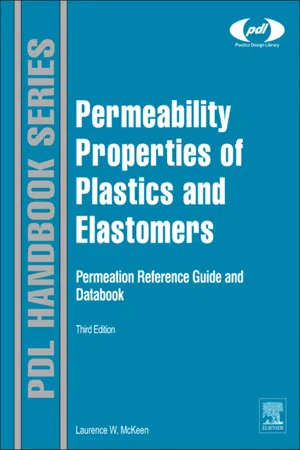
- 354 pages
- English
- ePUB (mobile friendly)
- Available on iOS & Android
Permeability Properties of Plastics and Elastomers
About This Book
Permeability properties are essential data for the selection of materials and design of products across a broad range of market sectors from food packaging to Automotive applications to Medical Devices. This unique handbook brings together a wealth of permeability data in a form that enables quick like-for-like comparisons between materials.
The data is supported by a full explanation of its interpretation, and an introduction to the engineering aspects of permeability in polymers.
The third edition includes expanded explanatory text which makes the book accessible to novices as well as experienced engineers, written by industry insider and author Larry McKeen (DuPont), and 20% new data and major new explanatory text sections to aid in the interpretation and application of the data.
- A unique collection of permeability data designed to enable quick like-for-like comparisons between different materials
- Third edition includes 20% new data and expanded explanatory text, which makes the book accessible to novices as well as experienced engineers
- Essential reference for materials engineers, design engineers and applications engineers across sectors including packaging, automotive and medical devices
Frequently asked questions
Information
1.1. History
Table of contents
- Cover image
- Table of Contents
- Dedication
- Series Page
- Front Matter
- Copyright
- Preface
- 1. Introduction to Permeation of Plastics and Elastomers
- 2. Introduction to Plastics and Polymers
- 3. Production of Films, Containers, and Membranes
- 4. Markets and Applications for Films, Containers, and Membranes
- 5. Styrenic Plastics
- 6. Polyesters
- 7. Polyimides
- 8. Polyamides (Nylons)
- 9. Polyolefins, Polyvinyls, and Acrylics
- Chapter 10. Fluoropolymers
- 11. High-Temperature and High-Performance Polymers
- 12. Elastomers and Rubbers
- 13. Environmentally Friendly Polymers
- 14. Multilayered Films
- Appendix A. Conversion Factors
- Appendix B. Reference Fuel Compositions
- Appendix C
- Index